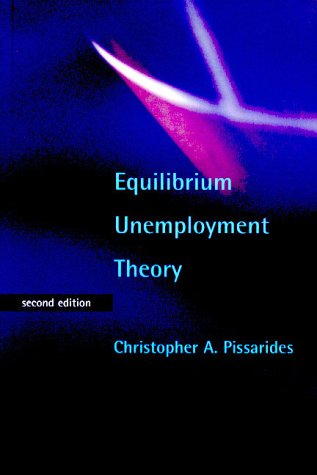Equilibrium Unemployment Theory Pissarides Pdf
[vIp.eBook] Equilibrium Unemployment Theory - 2nd Edition By Christopher A. Pissarides
|
- Equilibrium Unemployment Theory
- Keynesian Unemployment Theory
- Equilibrium Unemployment Theory Pissarides Pdf Download
- Equilibrium Unemployment Theory Pissarides Pdf Free
Equilibrium Unemployment Theory

Keynesian Unemployment Theory
- Aghion, P. and Howitt, P. (1994). Growth and unemployment. Review of Economic Studies, 61(3), 477–494.CrossRefGoogle Scholar
- Albrecht, J.W. Gautier, P.A. and Vroman, S. B. (2003). Matching with multiple applications. Economic Letters, 78, 67–70.CrossRefGoogle Scholar
- Attfield, C. and Silverstone, B. (1997). Okun's coefficient: A comment. Review of economics and statistics, 79, 326–329.CrossRefGoogle Scholar
- Axtell, R. (2001). Zipf distribution of u.s. firm size. Science, 293, 1818–1820.CrossRefGoogle Scholar
- Bell, B., Nickell, S. and Quintini, G. (2002). Wage equations, wage curves and all that. European Economic Review, 9, 341–360.Google Scholar
- Blanchard, J.O. and Diamond, P. (1990). The aggregate matching function, Growth, Productivity, Unemployment, MIT Press.Google Scholar
- Blanchflower, D. and Oswald, A. (1994). The wage curve, MIT Press, Cambridge, MA.Google Scholar
- Burdett, K. (1978). A theory of employee job search and quit rates. American Economic Review, 68, 212–220.Google Scholar
- Burdett, K., Shi, S. and Wright, R. (2001). Pricing and matching with frictions. Journal of Political Economy, 109(5), 1060–1085.CrossRefGoogle Scholar
- Caballero R.J. and Hammour, M. L. (1994). The cleansing effect of recessions. American Economic Review, 84, 1350–1368.Google Scholar
- Card, D. (1995). The wage curve: A review. Journal of Economic Literature, 33, 785–799.Google Scholar
- Diamond, P. (1971). A model of price adjustment. Journal of Economic Theory, 3(2), 156–168.CrossRefGoogle Scholar
- Diamond, P. (1981). Mobility costs, frictional unemployment, and efficiency. Journal of Political Economy, 89(4), 798–812.CrossRefGoogle Scholar
- Diamond, P. (1982a). Aggregate demand management in search equilibrium. Journal of Political Economy, 90(5), 881–894.CrossRefGoogle Scholar
- Diamond, P. (1982b). Wage determination and efficiency in search equilibrium. Review of Economic Studies, 49(2), 217–227.CrossRefGoogle Scholar
- Fagiolo, G., Dosi, G. and Gabriele, R. (2004). Matching, bargaining, and wage setting in an evolutionary model of labor market and outut dynamics. Advances in Complex Systems, 7(2), 157–186.CrossRefGoogle Scholar
- Fonseca, R., Lopez-Garcia, P. and Pissarides, C.A. (2001). Entrepreneurship, startup costs and unemployment. European Economic Review, 45, 692–705.CrossRefGoogle Scholar
- Gaffeo, E., Gallegati, M. and Palestrini, A. (2003). On the size distribution of firms: Additional evidence from the g7 countries. Physica A, 324, 117–123.CrossRefGoogle Scholar
- DelliGatti, D. et al. (2004). Business cycle fluctuations and firms' size distribution dynamics. Advances in Complex Systems, 7, 223–240.CrossRefGoogle Scholar
- Jovanovic, B. (1979). Job matching and the theory of turnover. Journal of Political Economy, 87, 973–990.Google Scholar
- Lagos, R. (2000). An alternative approach to search frictions. Journal of Political Economy, 108(5), 851–873.CrossRefGoogle Scholar
- Leombruni R. and Richiardi, M.G. (2005). Why are economists sceptical about agent-based simulations?. Physica A (forthcoming).Google Scholar
- Mortensen, D.T. (1982a). The matching process as a non-cooperative bargaining game. The Economics of Information and Uncertainty, University of Chicago Press, Chicago.Google Scholar
- Mortensen, D.T. (1982b). Property rights and efficiency in mating, racing, and related games. American Economic Review, 72(5), 968–979.Google Scholar
- Mortensen, D.T. and Pissarides, C.A. (1994). Job creation and job destruction in the theory of unemployment. Review of Economic Studies, 61, 397–415.CrossRefGoogle Scholar
- Mortensen, D.T. (1999). New developments in models of search in the labor market. Handbook of Labor Economics (O. C. Ashenfelter and D. Card, eds.), North-Holland, Amsterdam.Google Scholar
- Neal, D. and Rosen, S. (2000). The theory of earnings distributions, Handbook of Income Distribution (A. Atkinson and F. Bourgignon, eds.), North-Holland.Google Scholar
- Okuyama, K., Takayasu, M. and Takayasu, H. (1999). Zipfs law in income distribution of companies. Physica A, 269 125–131.CrossRefGoogle Scholar
- Petrongolo, B. and Pissarides, C.A. (2001). Looking into the black box: A survey of the matching function. Journal of Economic Literature, 39, 390–432.Google Scholar
- Phelps, E.S. (ed.). (1970). Microeconomic foundations of employment and inflation theory. Norton.Google Scholar
- Pissarides, C.A. (1984a). Efficient job rejection. Economic Journal, 94, 97–108.CrossRefGoogle Scholar
- Pissarides, C.A. (1984b). Search intensity job advertising and efficiency. Journal of Labor Economics, 2(1), 128–143.CrossRefGoogle Scholar
- Pissarides, C.A. (2000). Equilibrium unemployment theory. 2 ed., MIT Press, Cambridge, MA.Google Scholar
- Prachowny, M. (1993). Okun's law: Theoretical foundations and revised estimates. Review of Economics and Statistics, 75, 331–336.CrossRefGoogle Scholar
- Richiardi, M.G. (2004). A search model of unemployment and firm dynamics. Advances in Complex Systems, 7(2), 203–221.CrossRefGoogle Scholar
- Rogerson, R., Shimer, R. and Wright, R. (2004). NBER Working Papers, no. 10655.Google Scholar
- Smith, A.E. and Zenou, Y. (2003). A discrete-time stochastic model of job matching. Review of Economic Dynamics, 6(1), 54–79.CrossRefGoogle Scholar
- Sonnessa, M. (2004). The jas (java agent-based simulation) library. Industry and Labor Dynamics: The Agent-based Computational Economics Approach. Proceeding of the Wild@Ace 2003 conference” (Singapore) (R. Leombruni and M. Richiardi, eds.), World Scientific Press.Google Scholar
- Stigler, G.J. (1961). The economics of information. Journal of Political Economy, 69(2), 213–225.CrossRefGoogle Scholar
- Tesfatsion, L. (2005). Agent-based computational economics: A constructive approach to economic theory. Handbook of Computational Economics, Volume 2: Agent-Based Computational Economics, North-Holland, (forthcoming).Google Scholar
Equilibrium Unemployment Theory Pissarides Pdf Download

Equilibrium Unemployment Theory Pissarides Pdf Free
Equilibrium Unemployment Theory. An equilibrium principle of unemployment assumes that companies and staff maximize their payoffs underneath rational expectations and that wages are decided to take advantage of the personal features from commerce. This book focuses on the modeling of the transitions out and in of unemployment. BUSINESS CYCLES IN THE EQUILIBRIUM MODEL OF LABOR MARKET SEARCH AND SELF-INSURANCE Makoto Nakajima Federal Reserve Bank of Philadelphia August 5, 2010. The Mortensen-Pissarides search and matching model has become the standard theory of equilibrium unemployment (Mortensen and Pissarides (1994), Pissarides (2001)).
Chaos Faction 2 hackedwill continue your battle in the original. With this hacked version of Chaos Faction 2 surely that you will overcome challenges perfectly,this game offers for you three game modes such as Campaign, Deathmatch and Survival, so choose your favorite modes before starting.  Chaos Faction 2, a free online Action game brought to you by Armor Games. The long-awaited sequel to the classic Chaos Faction! Battle your way through 15 new campaign levels with new weapons, characters, moves, and more explosions than you can shake a stick of dynamite at. New features include: improved hand-to-hand combat, enhanced level editor, offline multiplayer, advanced character editor. Chaos Faction 2 with cheats: Keyhack [1] toggle Player 1 health, [2] toggle Player 2 health. Your mission in this long-awaited sequel to the classic Chaos Faction is to battle your way through 15 new campaign levels trying to defeat your opponents. Don't let him push you off of the platforms. Play Chaos Faction 2 Hacked. Choose your style of game play from Campaign, Deathmatch and Survival. Pick from loads of different characters and fight your way through each game modes in this 2nd game in the excellent Chaos Faction series. - Press key 1 while you play to get 9999 lives for player 1 press key 2 to get the same for p2. Play Chaos Faction 2 – From ArcadePrehacks.com. The long-awaited sequel to the classic Chaos Faction! Battle your way through 15 new campaign levels with new weapons, characters, moves, and more explosions than you can shake a stick of dynamite at. New features include: improved hand-to-hand combat, enhanced level editor, offline multiplayer, advanced character editor, unlockable game.
Chaos Faction 2, a free online Action game brought to you by Armor Games. The long-awaited sequel to the classic Chaos Faction! Battle your way through 15 new campaign levels with new weapons, characters, moves, and more explosions than you can shake a stick of dynamite at. New features include: improved hand-to-hand combat, enhanced level editor, offline multiplayer, advanced character editor. Chaos Faction 2 with cheats: Keyhack [1] toggle Player 1 health, [2] toggle Player 2 health. Your mission in this long-awaited sequel to the classic Chaos Faction is to battle your way through 15 new campaign levels trying to defeat your opponents. Don't let him push you off of the platforms. Play Chaos Faction 2 Hacked. Choose your style of game play from Campaign, Deathmatch and Survival. Pick from loads of different characters and fight your way through each game modes in this 2nd game in the excellent Chaos Faction series. - Press key 1 while you play to get 9999 lives for player 1 press key 2 to get the same for p2. Play Chaos Faction 2 – From ArcadePrehacks.com. The long-awaited sequel to the classic Chaos Faction! Battle your way through 15 new campaign levels with new weapons, characters, moves, and more explosions than you can shake a stick of dynamite at. New features include: improved hand-to-hand combat, enhanced level editor, offline multiplayer, advanced character editor, unlockable game.